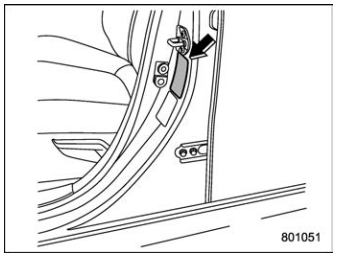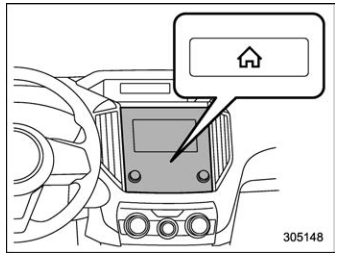Subaru Forester: Tires and wheels / Tire pressures and wear
Maintaining the correct tire pressures helps to maximize the tires’ service lives and is essential for good running performance. Check and, if necessary, adjust the pressure of each tire and the spare (if equipped) at least once a month and before any long journey.

Tire placard
Check the tire pressures when the tires are cold. Use a pressure gauge to adjust the tire pressures to the values shown on the tire placard. The tire placard is located on the door pillar on the driver’s side.
Driving even a short distance warms up the tires and increases the tire pressures. Also, the tire pressures are affected by the outside temperature. It is best to check tire pressure outdoors before driving the vehicle.
When a tire becomes warm, the air inside it expands, causing the tire pressure to increase. Be careful not to mistakenly release air from a warm tire to reduce its pressure.
NOTE
- The air pressure in a tire increases by approximately 4.3 psi (30 kPa, 0.3 kgf/cm2) when the tire becomes warm.
- The tires are considered cold when the vehicle has been parked for at least three hours or has been driven less than 1 mile (1.6 km).
WARNING
Do not let air out of warm tires to adjust pressure. Doing so will result in low tire pressure.
Incorrect tire pressures detract from controllability and ride comfort, and they cause the tires to wear abnormally.

- Correct tire pressure (tread
worn evenly)
Roadholding is good, and steering is responsive. Rolling resistance is low, so fuel consumption is also lower.
- Under inflated tire (tread worn
on shoulders)
Rolling resistance is high, so fuel consumption is also higher.
- Over inflated (tread worn in the
center)
Ride comfort is poor. Also, the tire magnifies the effects of road-surface bumps and dips, possibly resulting in vehicle damage.
If the tire placard shows tire pressures for the vehicle when fully loaded, adjust the tire pressures to the values that match the loading conditions.
WARNING
Driving at high speeds with excessively low tire pressures can cause the tires to deform severely and to rapidly heat up. A sharp increase in temperature could cause tread separation and destruction of the tires. The resulting loss of vehicle control could lead to an accident.
 Tire inspection
Tire inspection
Check on a daily basis that the tires
are free from serious damage,..
 Wheel balance
Wheel balance
Each wheel was correctly balanced
when your vehicle was new, but the
wheels will become unbalanced as
the tires become worn during use.
Wheel imbalance causes the steering
wheel to vibrate slightly at
certain vehicle speeds and detracts
from the vehicle’s straight-line stability...
Other information:
Subaru Forester 2019-2025 Owners Manual: Examples of the types of accidents in which the SRS curtain airbag will most likely deploy
The vehicle is involved in a severe side impact near the front seat or the rear seat. The vehicle rolls onto its side or the roof. The angle of vehicle tip-up is marginal or the skidding vehicle’s tires hit a curbstone laterally. An offset frontal collision that is severe enough to deploy the front airbag...
Subaru Forester 2019-2025 Owners Manual: Alternate operation method for models with “keyless access with push-button start system”
Access key fob Lock button An access key fob can be used as the remote engine start transmitter. Operate the lock button to start or stop the engine as follows. Before starting the engine Before using the remote engine start system to start the engine, confirm the following conditions...
Categories
- Manuals Home
- Subaru Forester Owners Manual
- Subaru Forester Service Manual
- If the passenger’s frontal airbag OFF indicator illuminates and the ON indicator turns off even when the front passenger’s seat is occupied by an adult
- Alarm system setting
- Reclining the seatback (if equipped)
- New on site
- Most important about car
Type B multi-function display (color LCD)
Turn the ignition switch to “ON”.

 button.
Select “Settings”.
Select “Vehicle”.
Select “Time/Date” and then select “Manual”.
button.
Select “Settings”.
Select “Vehicle”.
Select “Time/Date” and then select “Manual”.

 to complete the
clock
setting.
to complete the
clock
setting.
